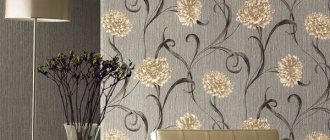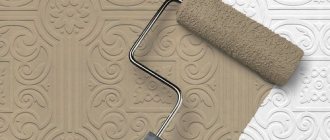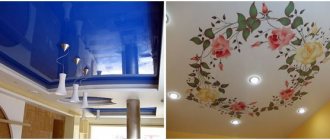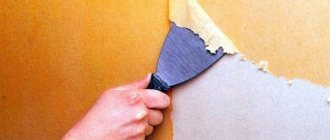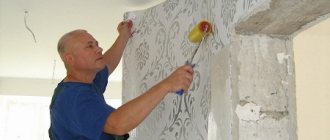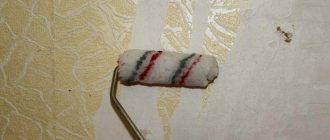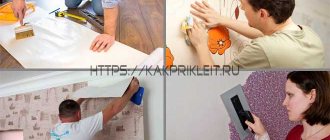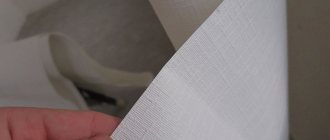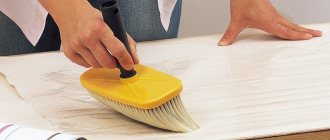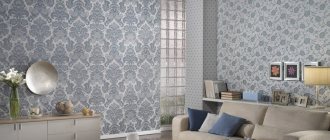Characteristics of non-woven wallpaper
Such wallpaper is made from long cellulose fibers. It is combined with synthetic additives, increasing strength and wear resistance. On sale there are both completely non-woven wallpapers and a combination of this material with vinyl.
Non-woven coverings are produced especially for painting. They can be different: smooth or textured, plain or patterned. Even if there is no special mark on the packaging of the non-woven wallpaper you like that it can be painted, you shouldn’t worry - absolutely all non-woven-based coatings are suitable for painting (even those with a vinyl top layer).
It is very important what kind of glue is used during installation. Wallpaper to be painted must be glued with a special compound for non-woven fabric. This glue reliably fixes the canvas on any surface. In addition, only it can withstand staining. Non-woven fabrics placed on regular wallpaper glue will simply fall off the walls when painted - the water from the paint will soak such glue.
The composition of the coatings is the same - non-woven fabric is a voluminous, lightweight material characterized by good strength. And the texture can be different: smooth surfaces, textured wallpaper, corrugated fabrics with various patterns.
Important! The larger the surface of the wallpaper, the more difficult it will be to paint it evenly. For your first painting experience, it is better to choose smooth non-woven wallpaper for painting.
Tools and materials
To paint non-woven wallpaper you will need the following tools and auxiliary materials.
- Spray gun (spray gun). If it is not possible to work with a spray gun, painting is done using a roller.
- Roller. It is more convenient to work with a velor roller or sheepskin with medium-length pile. Such a tool does not leave air bubbles on the surface, and there are no drips or clots after it. Foam rollers are not recommended.
- Velor roller for painting protruding relief
- Narrow brush. It is painted over those places where the roller does not reach.
- Tray (tray) for paint. Plastic bath with a special platform.
- Masking tape to protect adjacent surfaces. It is glued to the junction of the wall and ceiling, door jambs, window slopes, sockets and switches.
Advice! When using a non-contact method of applying paint using a spray gun, the service life of the wallpaper increases, they can be repainted more times. Before you begin painting work, protect the floor and furniture by covering them with PVC film or removing them from the danger zone.
What paint can you use to paint wallpaper?
Not all dyes are compatible with non-woven fabric. Walls covered with wallpaper may only be painted with water-dispersion paints, that is, paints that are soluble in water. Most suitable:
- water emulsion;
- latex paint;
- acrylic-based compositions.
If you choose by cost, water-based paint will be cheaper, but latex paint is the most expensive option. Covering ability is better with acrylic and latex. All types of dyes are absolutely safe for health.
Important! You can initially choose paint with a water-repellent effect. Then the walls can be easily washed.
If the purchased dye does not have hydrophobic properties, it is better to cover the wallpaper with a colorless compound after the main painting.
The wallpaper itself will help you choose the right paint - textured ones with convex patterns are easier to paint with a thicker latex-based composition. Where bright and rich shades are needed, acrylic is indispensable. To paint smooth walls in soft pastel colors, a water-based emulsion is enough.
A specially selected video will tell you which paint to choose:
Paint is applied in different ways:
- brush;
- foam rubber or fur roller;
- spray.
It is better for a novice painter to choose a roller and a small brush as a working tool.
A little theory
Wallpaper intended for painting is characterized by low water absorption. Paper ones are another matter. They quickly get wet from any moisture. If such wallpaper was poorly glued, then the wet part will swell and move away from the wall. Therefore, experienced craftsmen strongly do not recommend painting conventional wallpaper.
But, if all the wallpaper is glued well, then why not make a quick repair? You just need to make sure that all areas adhere well to the wall. As for non-woven wallpaper, it is quite difficult to paint them, since the decorative surface will simply absorb all the applied paint. Therefore, they are pre-prepared before painting.
You can paint ordinary wallpaper with any type of paint, but you need to take into account their features:
- Water-based paints are the cheapest. They are susceptible to moisture. You can paint paper ones only after treating them with PVA. More suitable for vinyl;
- Oil paints are allowed to work only with paper wallpaper;
- Water-based acrylics are characterized by fast drying time and the absence of a pungent odor. Suitable for non-woven fabric;
- Latex-based acrylic paints protect wallpaper well from moisture and other influences. For best results, apply several layers.
The best option for painting regular wallpaper of any type is considered to be latex. It protects the wallpaper and extends its service life. Allows you to wash the surface with any household chemicals after applying it.
Preparing the walls
Not only freshly pasted wallpaper can be used for painting, but also old coatings that have adorned the walls for many years. Depending on this, the preliminary preparation of walls for painting differs.
New wallpaper for painting is glued in accordance with the instructions for installing non-woven coverings. It is very important that the walls are as smooth as possible and that the canvases do not overlap - this will spoil the appearance of the room and the repair will be of poor quality.
After gluing new wallpaper, you need to dry it thoroughly. This will take at least two days. Experts recommend gluing wallpaper at a room temperature of 20-25ºС.
Advice! Under no circumstances should windows and doors be opened; there should be no drafts in a room with wet surfaces.
As for old wallpaper, you cannot do without preliminary cleaning. No paint will lie evenly on a contaminated surface. Non-woven wallpaper can be vacuumed and wiped with a damp cloth, while vinyl on a cellulose backing can be washed with soapy water. This treatment will not only clean the surface, but also degrease it.
All baseboards, window sills, slopes and other decorative elements are sealed with masking tape. The floor must be covered with paper or film.
How to paint wallpaper
After all the preparations, you can start painting:
- The paint is mixed in a jar until smooth and poured into a plastic tray.
- Roll the roller in the paint until it is well saturated with it. The excess is squeezed out onto the grooved part of the tray.
- Start work from the top corner of one of the walls. Roll the roller along the wall from bottom to top.
- The next strip is applied with a slight overlap. Gaps are unlikely to be avoided, especially if the paint is light.
- It is better to paint near the baseboard and ceiling with a brush.
- After the first layer has dried, apply the second, covering all gaps and eliminating possible defects.
- After a few hours, you can bring furniture into the room and use it. But it will take up to three weeks for the paint to dry completely. During this period, it is better not to lean against the wall and not to wipe the wallpaper.
The entire painting process is shown in the video:
Advice! Any paint becomes a little lighter after drying.
To ensure the authenticity of the shade, it is better to test the dye in advance on an inconspicuous area of the wall, for example, behind a cabinet.
Painting process
Before painting the wallpaper, you need to remove the furniture. As an option, cover with construction film. Then the places that need to be protected are sealed with tape: baseboards, trim, sockets, switches.
Sequence of work:
- Dust removal and degreasing of walls.
- Applying primer in 1-2 layers.
- Use a small roller or brush to paint corners, wallpaper near the ceiling (the ceiling is protected with a spatula), above the baseboard, around switches. One wall is being processed.
- The main surface is rolled up with a large roller.
- The remaining walls are painted in the same way.
- The second layer is performed after the first has dried, preferably within a day. The minimum interval between paintings is indicated in the instructions.
It is important to carefully paint the walls without leaving “bald spots” or streaks. A second layer is not always able to eliminate the flaws of the first, and then the wallpaper will have to be re-glued.
Other dyeing methods
According to the proposed instructions, it is enough to simply paint the walls yourself. Thus, it is easy to update the interior and add bright colors to the room. However, this is the simplest technique; experienced craftsmen know several more interesting ways of painting wallpaper:
- Quite often in renovations there is a combination of colors. It can be two or more shades of solid or contrasting colors. Tones are applied in accordance with the invented scheme (dividing the wall into zones, creating geometric patterns). Even more interesting is the mixing of colors - first, the entire wall is painted with one paint, and after drying, another is applied. Use a damp sponge to wipe off fresh paint in the most prominent places of the wallpaper pattern - this way even smooth surfaces become voluminous.
- You can also paint the reverse side of non-woven wallpaper. In this case, the color will be muted, with a dark base visible through the lighter pattern. Wallpaper can be pasted only after the dye has completely dried. You can diversify the technique by applying designs to the reverse side; these can be stencil patterns or simple spots (like camouflage).
- Highly skilled craftsmen can create real masterpieces on canvas. Using different paints and brushes, textured wallpaper is painted in several colors, working with the canvas like a child’s coloring book.
Advice! If there is no special mark on the wallpaper packaging stating that it is intended for painting, it is better to apply paint to a test section.
It is advisable to first glue a piece of wallpaper to the wall or plywood and let it dry. This will allow you to immediately check the properties of the glue and select the desired shade of paint.
Selective Pattern Creation Method
This option will require more care and patience. Especially if you choose a relief with small patterns. The wallpaper is painted in two colors. The first is to cover the entire surface, after drying they move on to the second shade. Which is used to paint relief patterns.
This option will require more care and patience.
Method of decorating wallpaper before gluing it to the surface
It is allowed to paint vinyl wallpaper in advance, before gluing it to the wall. It is then important to take measurements of the distance from floor to ceiling in order to prepare the stripes. On a flat surface, the canvas is painted in the desired color. It will be possible to glue the painted material in an hour. This option creates relief areas of a lighter color, the coloring itself looks beautiful.
On a flat surface, the canvas is painted in the desired color.
Sponge method
This method will take a lot of time, since the layer will be applied with a sponge, which cannot be used to cover the entire wall quickly. The final color is applied with a sponge soaked in paint; it leaves textured imprints on the wall that serve as a pattern.
This method will take a lot of time, since the layer will be applied with a sponge, which cannot be used to cover the entire wall quickly.
